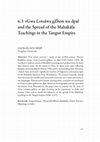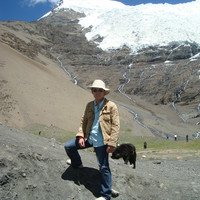Papers by Haoran Hou
中国文化, 2024
本文围绕着藏传佛教活佛转世制度展开,从藏文文献出发,以藏传佛教的内部视角,揭示活佛转世系统在西藏形成的前因後果,提出一个新的观点:活佛转世系统的形成与后弘期藏地本生故事的创作和观音信仰的传播紧密相关。
西域历史语言集刊, 2023
在東亞佛教的神佛世界中,觀音菩薩的影響力最大,信仰者最多,以至被稱為“半個亞洲的信仰”。觀音崇拜源自大乘佛教的菩薩信仰,在傳入中國後經歷了本土化發展,於漢傳和藏傳佛教體系中發展出不同的型態和特徵... more 在東亞佛教的神佛世界中,觀音菩薩的影響力最大,信仰者最多,以至被稱為“半個亞洲的信仰”。觀音崇拜源自大乘佛教的菩薩信仰,在傳入中國後經歷了本土化發展,於漢傳和藏傳佛教體系中發展出不同的型態和特徵。長期以來,中外學者對觀音信仰的研究傾注了極大的熱情,也發表了不少重要成果。然而,遺憾的是,目前為止尚未有學者將兩種佛教傳統的觀音信仰放在一起,從比較研究的角度進行分析和探討。為了填補這一空白,本文對漢藏傳佛教傳統中觀音崇拜進行比較研究,重點在於分析二者在義理和修持上的異同。在研究中,嘗試打破印度、漢傳和藏傳佛教之間被人為地建構起來的種種界定和壁壘,將印度、漢傳和藏傳佛教視作一個整體的、連續的和不斷發展變化的宗教傳統,分析觀音崇拜的思想和實踐是如何從同一源頭出發,在傳播過程中經過不斷衍化,最終形成漢藏佛教傳統中各具特色的觀音信仰體系。

BuddhistRoad Paper 2.3, 2022
Among the Tibetan Buddhist literature unearthed at Karakhoto, a number of ritual texts of the liṅ... more Among the Tibetan Buddhist literature unearthed at Karakhoto, a number of ritual texts of the liṅga effigies have recently been identified. These texts describe how to make and use the liṅga effigies for ritual purposes such as healing, inflicting harm, and exorcism. The rituals involving the use of the liṅga effigies had their origin in India, passed through Tibet, and spread to the Tangut Empire (ca. 1038-1227, in Chinese sources known as Xixia 西夏) and into the Yuan Dynasty (1271-1368, 元). So far, not much is known about the performance and transmission of the liṅga rituals in Eastern Central Asia. To fill this gap, this paper translates and annotates the ritual texts from the Karakhoto documents and in doing so illustrates how the liṅga effigies were made and used by people at the time, and further explores their transmission across Eastern Central Asia between the 11th and 14th centuries.
Buddhism in Central Asia II: Practice and Rituals, Visual and Material Transfer, 2022
This is an open access chapter distributed under the terms of the CC BY-NC 4.0 license.
Buddhism, Culture and Society in Bhutan ed. S. Kumagai. PP. 35-68, 2018
Buddhism in Central Asia II
This is an open access chapter distributed under the terms of the CC BY-NC 4.0 license.

Cahiers du Mirror, 2018
To date the Yul phyogs so soʼi gsar ʼgyur me long or Melong, edited by Tharchin from 1925 to 1963... more To date the Yul phyogs so soʼi gsar ʼgyur me long or Melong, edited by Tharchin from 1925 to 1963 in the cosmopolitan trade hub of Kalimpong at the foothills of the eastern Himalayas, is perhaps the best-known Tibetan language newspaper. It was widely read not only by the local Tibetophone community but also in Lhasa and across Tibet and even by a small readership across the globe as the surfacing collections of issues e.g. in Prague, Paris, Oxford or London demonstrate. It is beyond doubt that the Melong was one of the most important sources for news from Tibet and all over the world at the time.
Nevertheless, the Melong was no solitaire appearance but represents an early apogee in the history of the development of the press and popular mass media in Tibetan language. Over the following pages we will thus attempt to give an overview of the history of Tibetan language newspapers in order to provide some background and context deemed necessary to fully appreciate the role and function played by the Melong.
In comparison, Tibetan newspapers are a relatively late development.
Books by Haoran Hou
Conference Presentations by Haoran Hou

From Jetavana to Jerusalem: Sacred Biography in Asian Perspectives and Beyond, Essays in Honour of Professor Phyllis Granoff, 2022
This article presents a study of the twelfth-century Tibetan Buddhist master rGwa Lotsāwa gZhon n... more This article presents a study of the twelfth-century Tibetan Buddhist master rGwa Lotsāwa gZhon nu dpal (1105-before 1193). He travelled to India in search of Buddhist teachings and studied there for more than thirteen years. On his return to Tibet, he spent seven years collecting disciples and preaching in Eastern Tibet and its surrounding areas. Recently, scholars have recovered a significant number of fragments and manuscripts of the Mahākāla literature from Kharakhoto. The textual materials, dating from between the twelfth and fourteenth centuries, are written primarily in two languages, Tibetan and Chinese. Among them, a number are attributed to rGwa Lotsāwa gZhon nu dpal. Based on his biography and the excavated documents from Kharakhoto, this paper aims to examine the life story of rGwa Lotsāwa gZhon nu dpal, focusing on his experiences in India and Eastern Tibet, and to clarify his influence on the spread of the Mahākala teachings in the Tangut Empire (1038-1227).











Uploads
Papers by Haoran Hou
Nevertheless, the Melong was no solitaire appearance but represents an early apogee in the history of the development of the press and popular mass media in Tibetan language. Over the following pages we will thus attempt to give an overview of the history of Tibetan language newspapers in order to provide some background and context deemed necessary to fully appreciate the role and function played by the Melong.
In comparison, Tibetan newspapers are a relatively late development.
Books by Haoran Hou
Conference Presentations by Haoran Hou
Nevertheless, the Melong was no solitaire appearance but represents an early apogee in the history of the development of the press and popular mass media in Tibetan language. Over the following pages we will thus attempt to give an overview of the history of Tibetan language newspapers in order to provide some background and context deemed necessary to fully appreciate the role and function played by the Melong.
In comparison, Tibetan newspapers are a relatively late development.